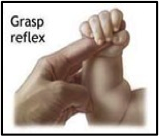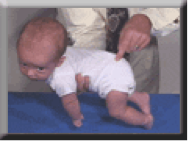Primitive Reflexes
 What are Primitive Reflexes?
What are Primitive Reflexes?
According to Dr. Stacy Gray, the primitive reflexes are involuntary muscle movements that originate from the brainstem. They develop in-utero and are essential during the first few months of life for survival. Typically, by the age of one, all primitive reflexes should be diminished or inhibited as the reflexes have a limited life-span. As the primitive reflexes are inhibited, the newborn acquires new skills and higher centers of the brain begin to mature and develop. The Primitive Reflexes include the Moro, Palmar, Plantar, Asymmetric Tonic Neck Reflex, Spinal Galant, Rooting, Babinski, Landau, Tonic Labyrinthine, and Symmetric Tonic Neck Reflex.
What happens when Primitive Reflexes Persist?
The persistence of these reflexes can indicate damage to the brain or can indicate immaturity within the nervous system. Children who have Neurodevelopmental Disorders like ADD/ADHD, Sensory Processing Disorder, Autism, or other Learning Disorders typically have retained primitive reflexes that can contribute to their symptoms and affect learning and their behavior.
Each primitive reflex is associated with one or more of the sensory processing systems and can affect Auditory, Taste, Tactile, Smell, Visual, Vestibular, and Proprioception. If a child presents with more than one retained reflex, the child will typically experience dysfunction in one or more of the sensory systems leading to a Neurodevelopmental Disorder or Sensory Processing Disorder.
What are Causes of retained Primitive Reflexes?
Parents often ask “Why are my child’s reflexes still present?” The birth process is important in the development and inhibition of the primitive reflexes. Therefore, a child born by C-section or a child that experienced birth trauma may have retained primitive reflexes. Additional causes can include: falls, traumas, lack of tummy time, delayed or absent creeping or crawling, chronic ear infections, head trauma, and vertebral subluxations.
The Primitive Reflexes:
The Moro Reflex

The Moro Reflex is typically referred to as the “Startle Reflex”. If your child becomes startled by a loud noise, sudden movement, or bright light, the baby will respond by extending their arms outward and then bringing them in over their chest. The reflex is normally inhibited by 2-4 months of age. The Moro Reflex seems to be connected with each of the senses and is the foundation for proper regulation.
If the reflex is not inhibited, the child or adult may over-react to auditory stimulation or have an increase in their other senses. The child will remain in a “fight or flight” mode constantly which leads to over activation of the Sympathetic Nervous System and the Adrenal Glands. The increased demands on the Adrenal Glands may cause the child to become fatigued and the child may have a weakened immune system and suffer from: allergies, asthma, and chronic illnesses.
Social/Learning/Behavioral Problems that may be present with a retained Moro Reflex:
- Motion Sickness
- Poor Balance and Poor Coordination
- Emotional immaturity, Shy, Withdrawn
- Inability to focus and easily distracted
- Difficulty with playing ball games
- Easily fatigues with activity or school work
- Allergies and decreased immunity
- Does not adapt well to change in routine
- Mood swings and Anxious
Sensory Systems affected: Auditory, Tactile, Visual, Vestibular & Proprioceptive
The Rooting Reflex

Lightly stroking the baby’s cheek will cause her to turn her head towards you and open her mouth. The reflex is strongest immediately following birth and is reinforced by initially breastfeeding your baby. After each feeding, the reflex disappears temporarily but should be completely diminished by 3-4 months of age.
Social/Learning Problems that may present with retained Rooting Reflex:
- Difficulty with solid foods
- Messy eaters and dribbling
- Poor articulation
- Poor Manual Dexterity (Connected with the Palmar Reflex)
Sensory Systems Affected: Tactile and Proprioceptive
The Palmar Reflex

The Palmar Reflex is also noted as the “Grasp Reflex” and develops in utero. Placing your finger or a small object in the open palm of your baby’s hand will cause the baby to grasp or grip it. Usually by 3-4 months of age the reflex is inhibited. The Palmar Reflex is related to feeding and sucking so a persistent reflex can cause “overflow” movements while the child is writing (sticking tongue out).
Social/Learning Problems that may present with retained Palmar Reflex:
- Difficulty with writing and Poor Pencil grip
- Poor manual dexterity affecting thumb and finger movement
- Poor Fine motor skills
- Intertwined speech and hand movements can lead to speech difficulty
Sensory Systems Involved: Tactile and Proprioception
Asymmetrical Tonic Neck Reflex (ATNR)

When the ATNR is performed it is referred to as placing the child in the “Fencer Position”. The reflex should be diminished by 4-6 months. The reflex is initiated by laying the baby on their back and turning their head to one side. The arm and leg on the side that he is looking towards should extend, while the opposite arm and leg flex or bend. The ATNR develops in utero and is strengthened with the birth process. Developmentally, the ATNR is very important is preparing the baby for movements like rolling and for activities that require the child to cross the mid-line of their body.
Social/Learning Problems that may present with a retained ATNR:
- Possible Scoliosis
- Poor handwriting
- Difficulty with activities that cross midline
- Difficulty reading and tracking (as the child turns the head to read the arm may extend outward causing reading to be difficult)
- Poor hand eye coordination
- Delayed crawling
Sensory Systems Involved: Auditory, Vestibular, Visual, and Proprioceptive
Symmetrical Tonic Neck Reflex (STNR)

The STNR is also referred to as the “Crawling Reflex”. The reflex is present briefly after birth and then appears again around 6-9 months and should be inhibited by 9-11 months. The child should be on hands and knees and as the head is brought towards the chest the arms bend and the legs extend. As the head is brought back and extended, the arms straighten out and the legs bend. The Reflex helps to divide the body in half at the midline.
Social/Learning Problems that may be present with retained STNR:
- Poor posture, slumps while writing
- Poor eye hand coordination
- Clumsy
- Difficulty with synchronized movements like swimming
- Sits in “W” position for stability
- Difficulty with eye focusing on near and far objects
- Attention affected because of discomfort sitting in one position
Sensory Systems Involved: Visual, Vestibular, and Proprioception
Spinal Galant Reflex

The Spinal Galant is present in utero and facilitates the birth process by helping bring the baby down the birth canal. The reflex is usually inhibited by 3-9 months. In utero the Spinal Galant Reflex is thought to have an impact on sound conduction that can later impact a child’s hearing. The newborn is placed on their stomach or held and the doctor strokes one side of their spine. Normally, the child will flex sideways toward the side that was stroked or stimulated. On the older child the reflex can be tested with the child on their hands and knees. Stroking both sides of the spine will induce urination and is the Pulgar Marx Reflex. The presence of the reflex on one side of the older child can present with posture abnormalities like scoliosis and gait abnormalities.
Social/Learning Problems that may be present with retained Spinal Galant:
- Difficulty sitting still, “Ants in the pants”
- Possible Scoliosis and Poor Posture
- Poor Bladder Control, Persistent bed wetting beyond 5 years
- Gait Abnormalities, Hip Rotation to one side while walking
Sensory Systems involved: Auditory, Tactile, and Proprioception
Tonic Labyrinthine Reflex (TLR)
To examine this reflex in an infant, place child on their back and tilt their head backwards. The backward motion causes the legs to stiffen, straighten, and the toes to point. The hands will become fisted and the arms bend at the elbows. The TLR prepares the infant for rolling over, creeping, crawling, standing, and walking. If the reflex is not inhibited, the child will exhibit abnormal extensor muscle tone. Inhibition of the TLR requires maturation of the neurological system and is a gradual process and typically disappears around 3 ½ years of age.
Social/Learning Problems that may be present with retained TLR:
- Poor posture and child will sit with head in flexed position
- Difficulty paying attention
- Motion sickness
- Dyspraxia
- Toe Walking
- Dislikes physical education class
- Poor sense of timing and no rhythm
- Difficulty with judging space, distance, depth and speed with makes sports difficult
Sensory Systems Involved: Vestibular, Proprioceptive, Auditory, and Visual

